Chip Sgro’s journey into the world of guitars began in a quintessentially 1960s fashion, fueled by S&H Green Stamps and a desire to strum. His first guitar, a plastic, yellow-and-red nylon-string model, was a far cry from the legendary instruments he would eventually collect, but it sparked a lifelong passion. From humble beginnings, amassing what he jokingly calls a “small collection” of four or five guitars, Sgro’s interest took a turn towards the extraordinary when his wife, Kim, gifted their children The Beatles: Rock Band. The plastic replicas of Paul McCartney’s Höfner bass and John Lennon’s Rickenbacker 325 ignited a new flame, pushing Sgro down a path of acquiring vintage instruments, specifically, iconic Beatles Guitars.
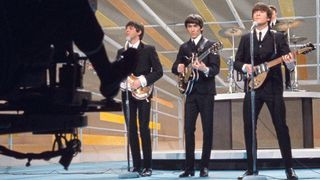 The Beatles performing on the Ed Sullivan Show, February 1964. Paul McCartney is playing his Höfner 500/1 bass, George Harrison a Gretsch Country Gent, and John Lennon the Rickenbacker 325.
The Beatles performing on the Ed Sullivan Show, February 1964. Paul McCartney is playing his Höfner 500/1 bass, George Harrison a Gretsch Country Gent, and John Lennon the Rickenbacker 325.
It wasn’t long before Kim’s thoughtful gifts extended beyond video game peripherals. A 1965 Höfner violin bass arrived, marking the true beginning of Sgro’s focused pursuit: to collect “key Beatle guitars” in exceptional condition. He generously shared some of the most prized pieces from his collection, offering insights into their history, their significance to the Beatles’ groundbreaking sound, and their personal meaning to him as a dedicated fan and collector. Join us as we delve into Chip Sgro’s remarkable collection of beatles guitars, each instrument echoing the sounds that shaped a generation.
1963 Gretsch 6119 Chet Atkins Tennessean: Harrison’s Workhorse
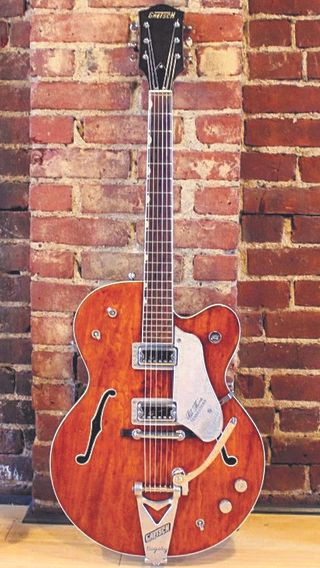 Close-up of a 1963 Gretsch Tennessean guitar, part of a Beatles guitar collection, showcasing its double-cutaway body and Hilo'Tron pickups
Close-up of a 1963 Gretsch Tennessean guitar, part of a Beatles guitar collection, showcasing its double-cutaway body and Hilo'Tron pickups
The Gretsch Tennessean, launched in 1958, evolved into a double-cutaway marvel by 1962, boasting a slimmer profile, dual single-coil Hilo’Tron pickups, and distinctive painted-on f-holes. George Harrison adopted the ’63 model as a staple, wielding it both in live performances and studio sessions. Eagle-eyed fans can spot Harrison’s Tennessean in the Beatles’ film Help!.
“When I first became serious about collecting beatles guitars, George’s instruments were my primary focus,” Sgro explains. “Looking at his guitar history, the ‘holy trinity’ for early Harrison fans are the ‘57 Duo Jet, the ‘62 Country Gentleman, and the ‘63 Tennessean. The Tennessean was my first acquisition of the three, mainly because it’s somewhat more attainable.”
Sgro’s Tennessean, discovered in a Guitar Center’s vintage section in California, presents a unique detail: “It has two serial numbers, which is quite unusual. The official number on the headstock dates it to 1963, but there’s another number marked in white on the back. Its meaning remains a mystery to me. Despite this quirk, the guitar is remarkably well-preserved.”
1957 Gretsch 6128 Duo Jet: George’s “First Good Guitar”
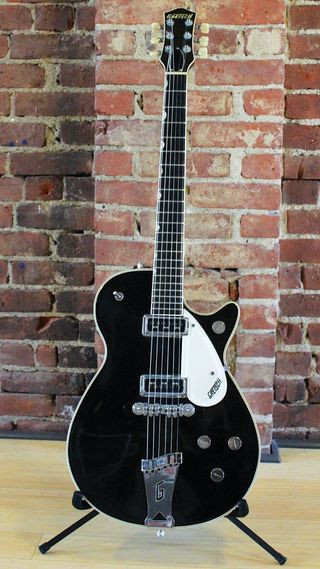 Detailed shot of a 1957 Gretsch Duo Jet guitar, highlighting its DeArmond Dynasonic pickups and G-marked tailpiece from a Beatles guitar enthusiast's collection
Detailed shot of a 1957 Gretsch Duo Jet guitar, highlighting its DeArmond Dynasonic pickups and G-marked tailpiece from a Beatles guitar enthusiast's collection
George Harrison affectionately called his ’57 Duo Jet his “first good guitar,” a testament to its pivotal role in the Beatles’ early sound. This guitar resonated through early Beatles singles, the raw energy of the Please Please Me sessions, and countless gigs that defined Beatlemania’s initial surge. Sgro’s pursuit of this iconic instrument led him to Willie’s American Guitars in St. Paul, Minnesota. “I had been searching for a ’57 Duo Jet for quite some time when I found this example,” he recalls. “It’s a fascinating ‘transition’ model, likely crafted in late 1957.”
He elaborates on the nuances that intrigue vintage guitar aficionados: “While some might point out that it isn’t exactly the same year as Harrison’s – mine features Neo-Classic thumbnail fret markers typical of the ’58 models, unlike the hump block inlays on Harrison’s ’57 – it retains the essential ’57 features: DeArmond Dynasonic pickups and the body style. Another distinction is the tailpiece; Harrison’s had a Bigsby tremolo, while mine has the original ‘G’ marked tailpiece.”
Sgro appreciates these subtle differences, noting, “These variations, from a collector’s viewpoint, actually made it slightly more accessible. Ultimately, it’s an exceptional guitar. Plug it into a classic Vox AC15 or AC30, and the raw, electrifying tones from Please Please Me instantly come alive. It’s like stepping back into the Cavern Club.”
Circa 1955 Gibson J-160E: The Ever-Present Acoustic-Electric
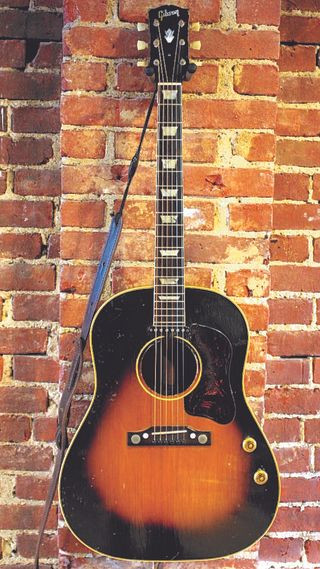 A vintage circa 1955 Gibson J-160E acoustic-electric guitar, part of a collection of Beatles guitars, featuring its sunburst finish and single-coil pickup
A vintage circa 1955 Gibson J-160E acoustic-electric guitar, part of a collection of Beatles guitars, featuring its sunburst finish and single-coil pickup
A significant chapter in beatles guitar history began on September 10, 1962, when John Lennon and George Harrison received nearly identical Gibson J-160E acoustic-electric guitars. These instruments became songwriting companions and studio workhorses during the Please Please Me and With the Beatles eras. Lennon’s original J-160E was tragically stolen in 1963 (unbeknownst to them, they had swapped guitars initially), later replaced, and remarkably, the original resurfaced in 2014, fetching over two million dollars at auction.
“The Beatles association makes finding a J-160E, especially in good condition, incredibly challenging,” Sgro remarks. “And they are undeniably expensive. My J-160E is actually an earlier model than John and George’s, dating back to ’55 or ’56, while theirs were ’62 models. Nevertheless, I was thrilled to acquire it.”
He emphasizes its unique place in Beatles history: “To the best of my knowledge, the J-160E is the only guitar that graced every single Beatles album, from Please Please Me to Abbey Road. This particular example boasts a stunning finish, bearing the perfect amount of wear and tear in just the right places. Sometimes, you encounter a guitar that simply compels you – ‘I have to own it, regardless of how it sounds.’ In this case, it not only possessed that visual appeal, but also delivered exceptional sound quality, making it an irresistible acquisition.”
1967 Epiphone Casino E230TD: A Casino for Every Beatle Guitarist
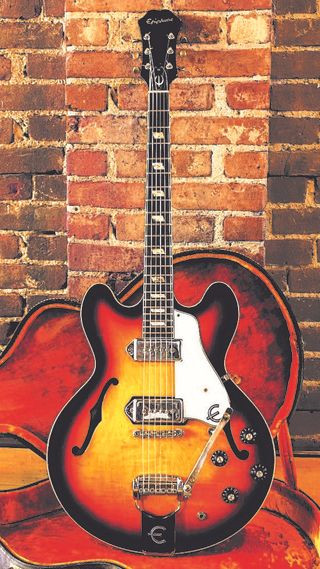 A 1967 Epiphone Casino E230TD guitar, from a collection of iconic Beatles guitars, showcasing its distinctive semi-hollow body and P-90 pickups
A 1967 Epiphone Casino E230TD guitar, from a collection of iconic Beatles guitars, showcasing its distinctive semi-hollow body and P-90 pickups
The Epiphone Casino holds a special place in the pantheon of beatles guitars, famously embraced by Paul McCartney, John Lennon, and George Harrison in the mid-1960s. Casinos were heavily featured in studio recordings and became stage staples during the Beatles’ final tour in 1966. Later, both Harrison and Lennon opted to strip the sunburst finishes from their Casinos, with Lennon’s “natural finish” Casino becoming instantly recognizable during the band’s legendary 1969 rooftop concert at Apple headquarters. Paul McCartney’s enduring affection for his Casino continues to this day.
“The Epiphone Casino is highly sought after by Beatles enthusiasts because all three guitar-playing Beatles owned one,” Sgro states. “While I own a 2002 Casino, my quest was for a genuine ’60s model. This ’67 Casino is essentially identical to the ones used by the Beatles, with the minor exception of black control knobs instead of the gold ones on John and George’s guitars. It sounds fantastic and is in excellent condition.”
Sgro recounts the poignant story of acquiring this guitar: “It came to me through Danny Courtenay of Chelsea Guitars in New York City, a trusted source for many of my instruments. This guitar belonged to a collector friend of Danny’s who had sadly passed away. Danny was assisting his widow with selling part of the collection. He initially intended to keep the Casino for himself, but ultimately decided to offer it to my wife, Kim, as a birthday gift for me. He felt it was keeping the guitar ‘in the family.’ It was a bittersweet situation, making me cherish this particular Casino even more.”
2016 Fender Stratocaster “Rocky”: A Psychedelic Statement
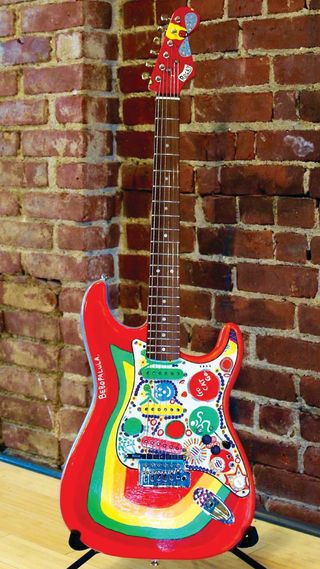 A vibrant 2016 Fender Stratocaster "Rocky" replica, part of a Beatles guitar collection, capturing the psychedelic paint job of George Harrison's iconic guitar
A vibrant 2016 Fender Stratocaster "Rocky" replica, part of a Beatles guitar collection, capturing the psychedelic paint job of George Harrison's iconic guitar
In 1965, George Harrison and John Lennon acquired matching 1961 Fender Stratocasters with Sonic Blue finishes, adding another dimension to their evolving beatles guitar arsenal. Harrison prominently used his Stratocaster throughout the Rubber Soul sessions that year, most notably on “Nowhere Man.” By 1967, in a burst of psychedelic creativity before the Beatles’ performance of “All You Need is Love” for the Our World global satellite broadcast, Harrison adorned his Strat with vibrant fluorescent Day-Glo paint, christening it “Rocky.” This visually striking guitar also made an appearance in the “I Am the Walrus” segment of the Magical Mystery Tour film.
Regarding his “Rocky” replica, Sgro explains, “This is a more recent guitar, from the 2000s. My knowledge of its specific history is limited. Apparently, an artist painted it for a client who never claimed it. Danny Courtenay’s dealer friend recognized its potential and alerted Danny, who immediately contacted my wife. It became another memorable Christmas gift.”
“The paint job is remarkably faithful to the original, and it sounds great,” Sgro adds. “However, it’s not one I play frequently, mainly because I’m hesitant to chip the paint!” He laughs, acknowledging the irony, “Which, of course, defeats the purpose of a guitar designed to be played!”
1963 Gretsch 6122 Chet Atkins Country Gentleman: The Ed Sullivan Icon
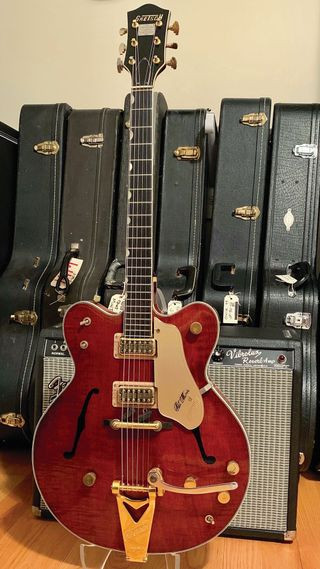 A pristine 1963 Gretsch 6122 Chet Atkins Country Gentleman guitar, from a Beatles guitar collection, highlighting its double-cutaway body and elegant aesthetics
A pristine 1963 Gretsch 6122 Chet Atkins Country Gentleman guitar, from a Beatles guitar collection, highlighting its double-cutaway body and elegant aesthetics
George Harrison owned two Country Gentleman guitars, one tragically lost when it fell from the band’s vehicle on the M1 motorway in 1965. However, the Country Gent achieved instant iconic status when Harrison played his 1963 model during the Beatles’ groundbreaking performance on The Ed Sullivan Show in February 1964, forever cementing its place in beatles guitar history.
“This Country Gentleman is among my most recent acquisitions, and it proved to be a challenging find,” Sgro reveals. “Firstly, these Gretsches, especially those associated with George, are highly valuable. Secondly, Gretsch bindings from that era are notorious for degrading and crumbling. While you might find a ’62 Country Gent, it often suffers from replaced or missing binding. This example retains its original binding, free of cracks, and the guitar is in near-mint condition.”
The provenance further elevates this instrument: “It even came with the original bill of sale, dated November 30, 1962, from Leonard’s in Fort Worth, Texas, for $575, along with the original ‘Gretsch Quality Control Department OK Card’ checklist. It’s truly an extraordinary instrument, made even more special by its rarity and impeccable condition.”
Brock & Sgro: From Beatles Covers to Original Music
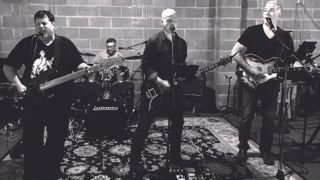 Chip Sgro and bandmate Alan Brock of Brock & Sgro, showcasing their musical collaboration born from a shared love of guitars and music
Chip Sgro and bandmate Alan Brock of Brock & Sgro, showcasing their musical collaboration born from a shared love of guitars and music
Chip Sgro’s passion for music extends beyond collecting beatles guitars. Years ago, he co-founded a cover band with fellow New Jersey musicians, performing beloved hits from the Beatles, Tom Petty, the Rolling Stones, and Foo Fighters – “typical cover band repertoire,” he says. When band commitments became challenging, Sgro and bandmate Alan Brock, whom he praises as “a phenomenal lead guitarist,” embarked on a new creative venture: writing original songs.
Their collaborative process began with exchanging musical ideas via phone, which “snowballed from there,” according to Sgro. This led to Brock & Sgro’s debut album, No Reason to Complain, a 12-track collection meticulously crafted in Brock’s home studio, with the duo performing all vocals and instruments.
True to his collector’s spirit, Sgro utilized his prized guitars in the recording process, prominently featuring his 1942-’43 Gibson J-45, alongside a Rickenbacker 330/12 12-string, a 2016 Les Paul Custom “Lucy” replica, and his 2002 Epiphone Casino.
Discover Brock & Sgro’s latest release, Peace In A World Of War, mastered at the legendary Abbey Road Studios and available on all digital music platforms. Listen here.
